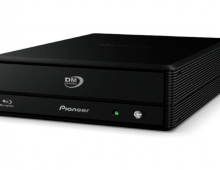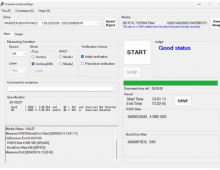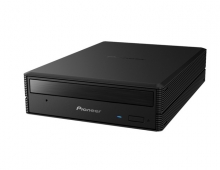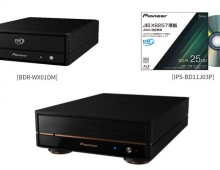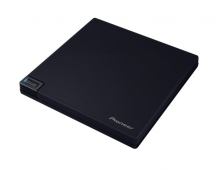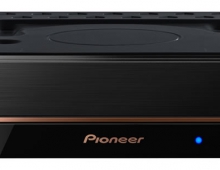
CEATEC: Pioneer Showcases 8x Blu-ray Burner Prototype
At Ceatec 2008, Japanese Pioneer Electronics has on display a new half-height Blu-ray bunrer prototype, the company's first to support
8x recording for Blu-ray.
The drive, which is expected to retail early next year, will join the already announced 8x BD burners from Panasonic, Buffalo and I-O Data Device (HLDS BH08N). Hitachi-LG Data Storage , Toshiba-Samsung Storage Technology and Lite-On IT do not yet offer 8x DVD burners under their brands.
It's main specifications include 8x write for BD-R and BD-R DL media, 2x for BD-RE and BD-RE DL, while it is also capable of burning DVD-R/+R at 16x, DVD-R/+R DL at 8x, DVD-RW at 6x, DVD+RW at 8x and DVD-RAM at 5x. The 40x/32x burning functions for CD-R/RW respectively complete the drive's specification list.
Among the basic functions of the drive are Pioneer's PowerRead and Pureread technologies. Both technologies migrate from Pioneer's DVD burners.
There is a difference between how AV and PC handle discs that are difficult to read. In a standard PC environment, DVD-Video is treated as 1 type of data; therefore, if a section is deemed unreadable, playback will stop. With PowerRead, the user-experience is similar to the AV side, making it possible to play the remainder of the disc. Note that with PowerRead, unreadable contents remain unreadable. PowerRead skips to the next readable address.
The PureRead function compensates the noise introduced when a scratched or dusty audio CD is reproduced. The idea behind PureRead is to try and correct damaged sectors, which are read from the Audio-CD. The feature re-reads damaged sectors to see if it can recover them (I.E. when ripping an Audio-CD). When these damaged sectors are read in a normal scenario, the sector may well be read without any serious error, but sometimes pops or crackles can be heard in the final ripped file. When a sector that is difficult to read is detected, the laser tries to re-read the damaged sector. Not just re-reading the sector, but the drive will actually adjust its read parameters (I.E. higher or lower laser power and the angle of the laser beam are adjusted) to try and get the best possible read-back from that damaged sector. An algorithm calculates the "best" or "average" result it achieves, and that information (I.E. the best-possible result) is then used as part of the final ripped MP3 file. Re-reading of damaged sectors can be up to a maximum of 40 times.
The function had been introduced in Pioneer's DVR-115D and DVR-215D series of DVD burners.
At the same event, Pioneer has on display a slim-type BD writer for notebooks. The prototype's specifications include 4x burning for BD-R/DL, 2x for BD-RE/RE DL, 8x for DVD-R/+R/+RW, 6x for DVD-R/+R DL and DVD-RW and 24x/24x for CD-R/RW.
Staying at Pioneer's booth, the R&D section includes Pioneer's multi-layer optical disc technology. Announced last July, the BD-compatible read-on-memory optical disc offers a capacity of 400 GB by using 16 layers. The company claims that clear signals from each recording layer are obtainable in a stable manner.
Ceatec Japan is an annual exhibition participated by electronics and IT firms from all over the world and this year it takes place from Sept 30 to Oct 4, 2008, at Makuhari Messe in Chiba Prefecture, Japan.
It's main specifications include 8x write for BD-R and BD-R DL media, 2x for BD-RE and BD-RE DL, while it is also capable of burning DVD-R/+R at 16x, DVD-R/+R DL at 8x, DVD-RW at 6x, DVD+RW at 8x and DVD-RAM at 5x. The 40x/32x burning functions for CD-R/RW respectively complete the drive's specification list.
Among the basic functions of the drive are Pioneer's PowerRead and Pureread technologies. Both technologies migrate from Pioneer's DVD burners.
There is a difference between how AV and PC handle discs that are difficult to read. In a standard PC environment, DVD-Video is treated as 1 type of data; therefore, if a section is deemed unreadable, playback will stop. With PowerRead, the user-experience is similar to the AV side, making it possible to play the remainder of the disc. Note that with PowerRead, unreadable contents remain unreadable. PowerRead skips to the next readable address.
The PureRead function compensates the noise introduced when a scratched or dusty audio CD is reproduced. The idea behind PureRead is to try and correct damaged sectors, which are read from the Audio-CD. The feature re-reads damaged sectors to see if it can recover them (I.E. when ripping an Audio-CD). When these damaged sectors are read in a normal scenario, the sector may well be read without any serious error, but sometimes pops or crackles can be heard in the final ripped file. When a sector that is difficult to read is detected, the laser tries to re-read the damaged sector. Not just re-reading the sector, but the drive will actually adjust its read parameters (I.E. higher or lower laser power and the angle of the laser beam are adjusted) to try and get the best possible read-back from that damaged sector. An algorithm calculates the "best" or "average" result it achieves, and that information (I.E. the best-possible result) is then used as part of the final ripped MP3 file. Re-reading of damaged sectors can be up to a maximum of 40 times.
The function had been introduced in Pioneer's DVR-115D and DVR-215D series of DVD burners.
At the same event, Pioneer has on display a slim-type BD writer for notebooks. The prototype's specifications include 4x burning for BD-R/DL, 2x for BD-RE/RE DL, 8x for DVD-R/+R/+RW, 6x for DVD-R/+R DL and DVD-RW and 24x/24x for CD-R/RW.
Staying at Pioneer's booth, the R&D section includes Pioneer's multi-layer optical disc technology. Announced last July, the BD-compatible read-on-memory optical disc offers a capacity of 400 GB by using 16 layers. The company claims that clear signals from each recording layer are obtainable in a stable manner.
Ceatec Japan is an annual exhibition participated by electronics and IT firms from all over the world and this year it takes place from Sept 30 to Oct 4, 2008, at Makuhari Messe in Chiba Prefecture, Japan.

